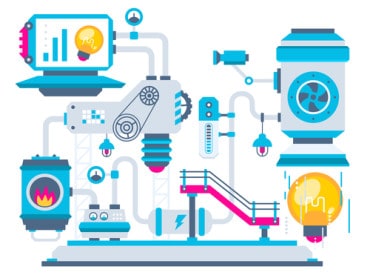
Automation’s true value is unlocked when it’s put in the hands of people who are closest to the business processes and workflows.
Enterprise automation technology is becoming increasingly prevalent in the modern workplace as organizations strive to digitize operations in the pandemic era, which acted as a sort of catalyst for chief information officers (CIOs) to accelerate digital growth. What IT leaders have achieved over the past two years is remarkable–from quickly enabling remote capabilities to accelerating the deployment of new digital solutions. And this pattern is expected to continue, as according to PwC, 60% of CIOs see digital transformation as one of the most important drivers of growth this year.

Enabling new business models for the new normal through technology helped prove that IT is a strategic value driver for businesses rather than an operational function. A recent Morgan Stanley report found that strong IT spending and demand for digital growth and operational efficiencies will continue in 2022. However, with all this newfound focus on IT, this uptick in spend and growth has come at the cost of adding more work to IT teams.
IT workloads have increased significantly and put a burden on IT teams to not only keep up with the demand but also keep pace with evolving technology. Digital transformation efforts can’t all be on IT teams to drive, which is why CIOs need to democratize automation across their organization to accelerate that transformation.
Thanks to the rise of low-code/no-code automation tools, more workers with non-technical backgrounds can lighten IT’s workload and help improve business outcomes. But just deploying low-code solutions isn’t enough to make a sustainable difference. Employee-driven automation is key to transformative change not only for the organization but also for the employees that form it.
Here is the 5-step proven approach which CIOs can follow to democratize automation and execute it as an automation program aligned with the business and IT strategies of the organization. It’s in the best interest of CIOs to take the lead and evangelize the citizen development program, avoiding the risk of Shadow IT in the organization. It ensures standardization and guardrails across all automation for successful program execution at scale.

Define personas
The very first step in democratizing automation is to identify the personas who will be involved in the automation program. Some of the key personas can be:
- Automation Center of Excellence (CoE), which centrally governs self-service automations and rolls-out automations to users. The CoE will focus on RPA workforce planning/reskilling, project delivery, development standards & practices, and adhering to audit compliance standards.
- IT Team who partners with the CoE and provides security controls and standards, control account provisioning, contribute to the Architecture design and ensure alignment with the enterprise architecture, manage required infrastructure, and provide data governance support.
- Citizen developers who develop automations for themselves (self-users). Some of them can also create automations for their teams/departments (expert users).
- RPA developers who create and test complex/enterprise automations that are distributed throughout the company by the COE.
- Automation users who consume automations developed by the CoE or citizen developers. They can also suggest their automations ideas to the CoE.
See also: Critical Step Zero for Enterprise-Wide Automation Adoption
Set up governance policies
Automation is not just transforming work processes but also the workplace and the workforce. And as technologies such as RPA, AI, and ML become more routine in day-to-day operations, CoEs should be created to ensure governance, standardization, and quality control.
For background, an automation CoE is an internal team that streamlines automation productivity, provides structure, and helps the business scale automation throughout the enterprise. Having a team of automation experts can help save time and money, ensuring that non-technical employees and the business get the most out of the automation program. The CoE enables both program governance as well as technical governance in partnership with the IT team. Program governance includes ideation control, license management, training, publishing, and monitoring automation. The technical governance includes user onboarding, provisioning, development standards, deployment procedures, auditing, and compliance. There are many benefits of establishing an automation CoE, including:

- Automation implementation is more likely to provide the best value and return when it is tailored specifically to an organization’s needs, rather than being a ‘one-size-fits-all’ solution. Having a dedicated team of experts is the best way to ensure your organization is using automation most effectively.
- An automation CoE is essential for the successful adoption and evangelism of technologies such as RPA. By providing a centralized location for knowledge sharing, solutions for common problems, and support, it establishes trust in the technology and provides the knowledge base necessary to support the use of automation by non-technical employees across the business.
Execution steps
Automation can alleviate the stress workers feel completing tedious, routine tasks and push them toward engaging in activities that allow them to exercise creativity, judgment, and problem-solving skills. However, most workers don’t realize the potential of technology and therefore don’t invest time in learning how to use it. That is why organizations need a carefully crafted training and enablement plan that ensures employees are aware of the ‘art of the possible’ and can utilize the automation platform and tools adopted by the organization.
One way to enhance people’s digital and technological skills is to offer education and training programs, including online courses that are scalable and easy to implement. These programs can increase awareness of new technologies, improve skills and competencies, and open doors to new career opportunities. By providing people with tools and training to become ‘do-it-yourself’-ers in automating their day-to-day tasks, organizations can not only improve employee workloads but also can retain and attract new talent.
Once the training and enablement plan is established, top-down consumption-based and bottom-up citizen development can be followed to execute the program.
- Top-down approach: CoE centrally ideates, prioritizes, develops, and distributes automations. As a result, employees can use and benefit from automation in their day-to-day work and suggest new ideas.
- Bottom-up approach: Citizen developers create automations themselves and submit them for validation to the CoE. Then, the CoE distributes automations to other employees.
Configure technologies
Once the personas are identified, the next steps are to configure the right technologies and tools for each persona. Based on the technical acumen, an organization might consider different tools for different groups such as low-code/no-code (drag-drop) automation development environment tools for citizen developers, and more complex and feature-rich tools for RPA developers.
Drive adoption
Embracing brand new technology in an employee’s workflow can be daunting if that employee has minimal technical knowledge and experience. That’s why creating top-down program support is a must which includes formal program establishment with clear targets/KPIs, gamification and recognition—and, if applicable allocating formal bandwidth for citizen developers. Then enabling bottom-up innovation and driving ongoing education helps to maximize adoption at scale. The employees should be empowered to suggest their automation ideas, create internal communities, and help employees get their ideas off the ground (for example, through hackathons). CIOs should identify and assemble automation champions, or early adopters, to inspire others within their peer group. By using their willingness to learn new skills and proactiveness to identify areas of opportunity – leadership will be able to inspire other employees through automation champions.
A recent study found that among employees who have heard of RPA, 60% have never used bots to perform tasks, yet 86% of employees want to use automation. The first step in identifying automation champions is by introducing employees to basic automation training. From there, CIOs and other leaders should watch out for employees who ask questions, are enthusiastic, and have an eye for strategy. Having automation champions is a great way to connect employees across the organization in a scalable, strategy-driven way and usher automation into every part of the business.
For so many businesses, the pandemic continues to introduce disruptive changes that create a burdensome workload on IT teams. And while technical leaders have achieved goals that were not thought possible, the advantages of automation technology need to be utilized by employees across the entire organization – not just ones with a technical background. By democratizing automation for every worker to leverage, CIOs can transform core processes in operations across the business and equip non-technical workers with the ability to streamline their own workflows. Automation’s true value is unlocked when it’s put in the hands of people who are closest to the business processes and workflows.





























